What is ganutel and where is it used?

Among the different types of needlework, there are quite simple, but at the same time cute. For example, ganutel, from which recently many craftswomen make flowers and costume jewelry. Basically, these are teardrop-shaped earrings of different colors, but in fact, the possibilities of this technique are endless. You can make bracelets, necklaces, tiaras, hairpins, and more. It all depends only on your imagination, and the necessary materials can easily be found even in your home.
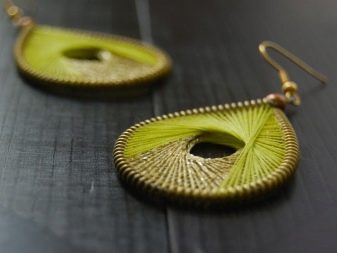
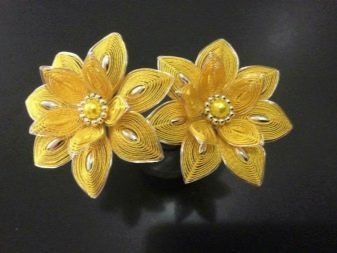
What it is?
It is believed that the history of the ganutel technique is associated with Brazil, where the earliest products of this kind are found. Initially, the locals used the roots of plants and wrapped algae on them, in the manner of Indian dream catchers. The manufacturing technique of these products really has a lot in common. However, unlike catchers, where branches are dried, algae and roots were taken raw, and ready-made products were dried.
Later, Ganutel migrated with Christian pilgrims to Malta.
Here the technique has changed significantly, thanks to which a new exclusive Maltese handicraft has appeared.
Local nuns decorated the churches and the area around them with ganutel flowers and other products... Gradually, their skills became so famous that students began to come to them, and the ganutel spread throughout the world.



Needlework has become so familiar to the Maltese and Catholics of Italy that even the very name of the technique was eventually taken in Italian. "Ganutel" is translated as "twisted thread", which exactly reflects the main element of the technique.
With the extinction of monasticism, the Maltese school also began to fade, however, at the initiative of the Government of Malta, budget schools and courses have recently begun to be created where you can learn this technique.
In Russia, the ganutel became popular not so long ago, but it confidently won admirers due to the simplicity and versatility of the technique. Nowadays it is not only everyday accessories and interior bouquets, but also evening or wedding decorations.

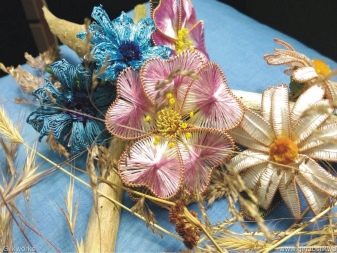
Materials and tools
The main materials for the ganutel technique are wire and fishing line or threads of different colors... For a beginner, the best copper wire and flossas these materials are relatively cheap and readily available at any sewing store. For the sake of special harmony of the product, you can pick up the wire and threads of the same color... Mouline thread comes in a silk or metallic sheen in different shades, so this won't be a problem. A more expensive option is silk threads.
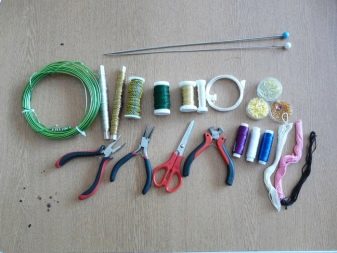
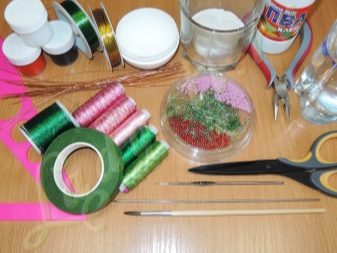
Copper wire it is also chosen because it is much easier to work with it than with steel. It is quite flexible and pliable, and also holds its shape well. Be sure to check the purchased skein for the quality of the color coating and elasticity. Poor-quality paint can peel off the wire during operation or on the finished product, which will inevitably ruin its appearance. And the excessive elasticity of the wire, which easily springs and bends poorly, suggests that this is not a copper wire, but an alloy of copper and steel - it is much more difficult to work with such a material.
If you are making flowers, you may need green satin ribbons. They are also sold at almost any clothing store.
Ribbons are needed at the final stage of work, when the flower has already been twisted and you need to give an aesthetic look to the stem... For these purposes, you can also use floss, however, then you will have to wind them on the wire for a long time. With ribbons, this work is done faster, and such a stem looks very beautiful.

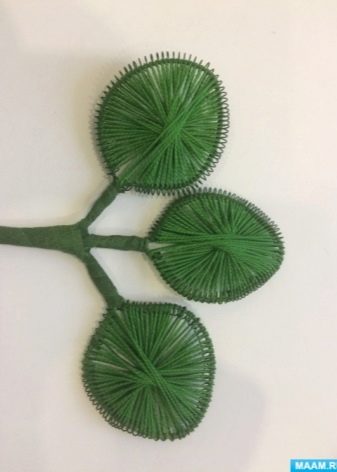
In addition to basic materials, you can use a lot of others. Some craftswomen even combine ganutel with other techniques. For example, with beading - such a tandem of needlework is very popular in floristic design. And stamens with the help of beads for flowers are used almost everywhere.
From tools to you you will definitely need a long knitting needle or hook (the diameter depends on the thickness of the threads selected for the product). Will also need wire cutters for wire or metal scissors, and scissors for ribbons and threads.

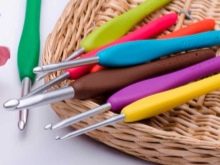
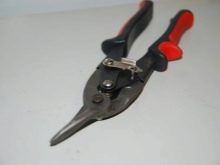
Execution technique
Ganutel is a very simple technique available for beginners.... You can easily make earrings or a flower with your own hands. Usually, it is necessary to cut off half a meter of wire for such a product. The step-by-step execution of such elements looks like this.
- Wrap the wire around a hook or knitting needle, holding it with your fingers so that all the turns are tightly adjacent to each other. This will make it easier to control the evenness of the turns, because strong deviations will be clearly visible on the finished product. You need to make about 40–45 turns, then hold the wire on the spoke for a few minutes so that it locks in a twisted shape.
- You will need two such springs for earrings, for a flower - according to the number of petals. Usually they are made at least five.
- Then remove the resulting spring from the knitting needle and roll it in the shape you chose for your product. After that, you need to twist the ends of the wire together so that the product is fixed. Now there is a frame of the product, and you can start braiding it with a thread.
- Take a thread of the desired color, hold its tip at the base of the "petal" and wind it around the entire perimeter.
- The simplest option is to cross-wind the thread onto the frame. In this way, a dense canvas with a wavy surface is created. It is better to bring the final winding of the thread to the base of the "petal". Here, the two ends of the thread need to be twisted and glued so that they do not unwind.
- For the flower stamens, take a piece of wire and a bead of a suitable color. Fold the wire in half and pass one end of it through the beads so that the bead is exactly in the middle.Now you can twist the ends of the wire or wrap them with thread.
- When all the petals and stamens are done, collect the flower and twist the ends of all the elements to make a single twisted trunk. This is the stem of the flower that you now need to wrap with tape. The product is ready!

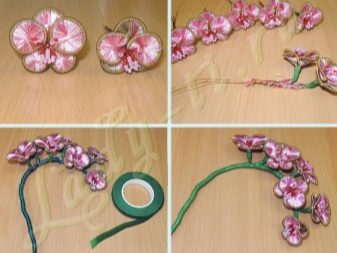
If you decide to make not a flower, but earrings or a pendant, you will need a very gently twist the ends of the wire and glue the ends of the thread.
Your best bet is to take a pair of wide-hole beads and slide the ends through.
The wire tip can also be used to make loop for earring from the other end of the bead, and then stretch the tip in the opposite direction and cut off there.
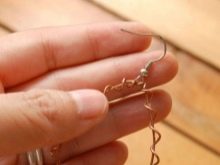
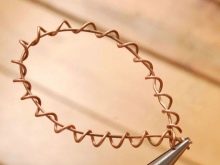
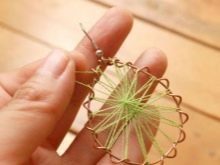
Where is it applied?
This technique can be used for any kind of craft. Adult women most often do decorations, and for preschoolers and in labor lessons in primary grades suitable flowers or pendants... This handicraft is safe for all children who already know how to use scissors.
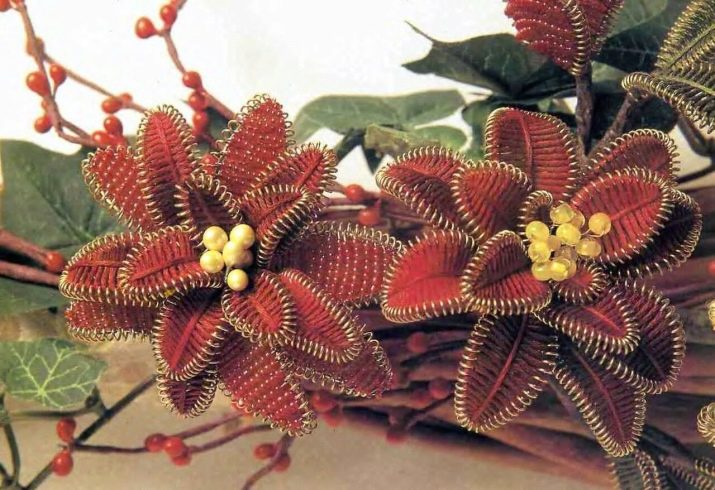
Also popular paintings with flowers and butterflies. To create them, you will additionally need superglue and thick cardboard to bring all the elements together. You will also have to monitor the quality of the wire twist, as poorly twisted short ends can eventually fall apart.
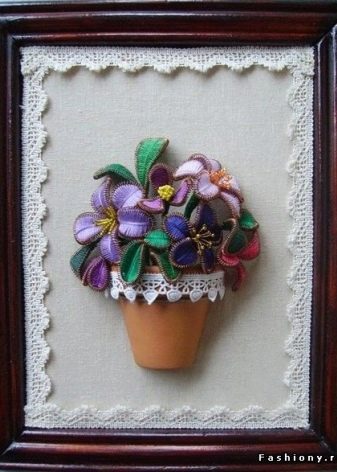
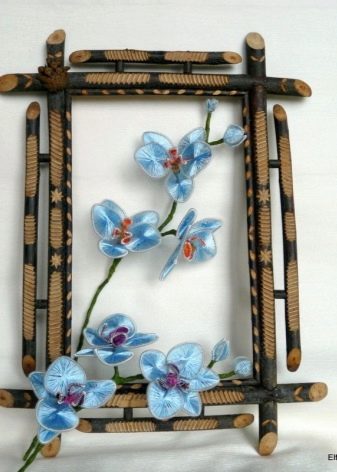
How to make an orchid using the ganutel technique, see the video.








